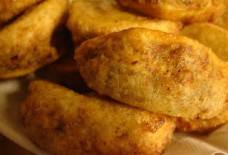Oum Ali--The Ancient Egyptian Bread Pudding
By: Blanche Shaheen/Arab America Contributing Writer
They say that necessity is the mother of invention. So when there was leftover stale bread throughout the ages, people loathed throwing out these scraps, especially since food was scarce. In the Arab world, they reinvented bread into other more enticing dishes like fattoush, where the leftover bread was transformed into croutons, adding crunch and heft to a fresh salad. “Fatteh” recipes were also popular, where bits of bread were added to casseroles of either chickpea, pine nuts, and hummus; or layered with eggplant, lamb, and yogurt.
In these dishes, the leftover bread provided a hearty starch replacement for rice. However, bread puddings are a whole other level of transformation, turning inexpensive scraps of bread into a decadent dessert with the addition of sugar and milk. As bread pudding dates back to ancient times, one can guess ancient Egypt provided the template for modern bread puddings, with the most popular one called Oum Ali.
Umm Ali–Egyptian dessertThere are several stories of how the mysterious Oum Ali originated, but the most pervasive legend focuses on a wealthy sultan on a hunting trip down the Nile River. He and his hunting party got hungry, so they made a pit stop at a poor village along the way. The locals called upon their best cook, Oum Ali, to feed the hungry sultan. “Oum” means mother in Arabic, so she was basically the mother of Ali. Since she had these unexpected royal guests, she whipped up a bread pudding using whatever she had on hand, like scraps of stale bread with nuts, dried fruits, and coconut and added milk and sugar to bake it all in the oven. Apparently the sultan loved the dessert so much he returned many times to eat this unique treat at the time. Egyptians still commemorate this dessert by naming it after the creator, Oum Ali.
Bread puddings can be sweet or savory, served warm or cold, simple or complex. Bread pudding’s foundational simplicity lends itself to countless preparations only limited by the imagination. In Oum Ali’s case, you can imagine she grabbed anything from her pantry, like almonds, pistachios, coconut, and sultanas. What makes this bread pudding luxurious, however, is the addition of puff pastry, which surpasses bread with a flaky texture and buttery flavor. No doubt this is a modern addition, but accepted as the traditional recipe nonetheless. Because puff pastry already has butter, there is no need to add extra butter to the recipe. Likewise, the use of condensed milk, which already has sugar in the milk, is all you need to sweeten this dish.
To see how this bread pudding is made, click on the video below:
Oum Ali – The Ancient Egyptian Bread Pudding
10 ounces puff pastry
1 14 ounces can condensed milk
1 1/2 cups half and half
½ tsp vanilla extract
½ tsp cinnamon
½ tsp rose water (optional)
½ cup pistachios (shelled)
½ cup slivered almonds
½ cup flaked coconut
¼ cup raisins
Preheat the oven to 400 degrees. Unroll the puff pastry and place them flat on baking sheets. Bake for 15 minutes, or until the puff pastry is puffed and golden. Remove from the oven and set aside. Break or cut the puff pastry into small pieces (about 1 to 2 inches). Place the broken pieces into a large bowl and mix evenly with the nuts, raisins, and coconut flakes. Place the pastry mixture into a greased 9×12 baking dish. In a saucepan, heat the sweetened condensed milk, half and half, vanilla, cinnamon on medium heat, and cook for about 3 minutes. Remove from the heat and pour the milk mixture over the puff pastry mixture, until the pastry is completely covered. Save any extra milk mixture for spooning on top. Bake uncovered, for about 30 minutes, or until the top springs back when lightly tapped. Garnish with more of the cream sauce if desired.
Blanche Shaheen is a journalist, host of the YouTube cooking show called Feast in the Middle East and a cookbook author. For more authentic and classical Middle Eastern recipes, you can now purchase her brand new cookbook: “Feast in the Middle East, A Personal Journey of Family and Cuisine” by clicking HERE:https://secure.mybookorders.com/Orderpage/2189
To check out her cooking video tutorials and other recipes follow Blanche on:
YouTube: https://www.youtube.com/user/blanchetv
Her blog at https://feastinthemiddleeast.wordpress.com/
Instagram: https://www.instagram.com/blanchemedia/
Facebook: https://www.facebook.com/FeastinTheMiddleEast
Check out Arab America’s Blog here!


